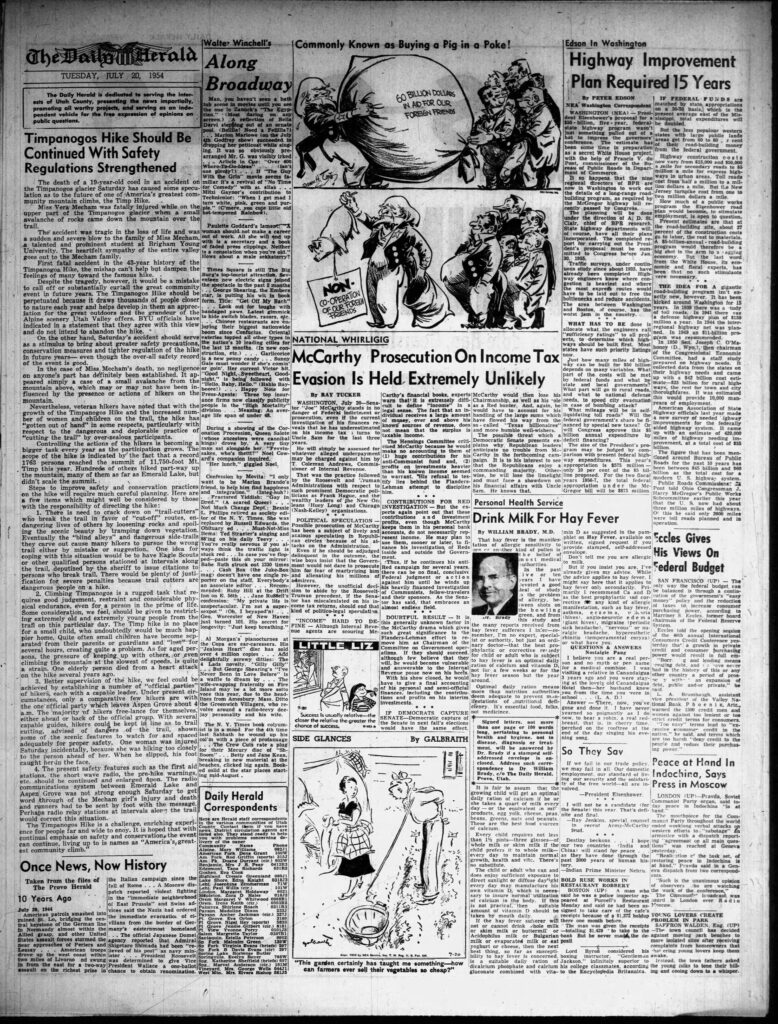The text below appeared in the July 20, 1954 edition of The Daily Herald.
Timpanogos Hike Should Be Continued With Safety Regulations Strengthened
The death of a 19-year-old coed in an accident on the Timpanogos glacier Saturday has caused some speculation as to the future of one of America’s greatest community mountain climbs, the Timp Hike.
Miss Vera Mecham was fatally injured while on the upper part of the Timpanogos glacier when a small avalanche of rocks came down the mountain over the trail.
The accident was tragic in the loss of life and was a sudden and severe blow to the family of Miss Mecham, a talented and prominent student at Brigham Young University. The heartfelt sympathy of the entire valley goes out to the Mecham family.
First fatal accident in the 43-year history of the Timpanogos Hike, the mishap can’t help but dampen the feelings of many toward the famous hike.
Despite the tragedy, however, it would be a mistake to call off or substantially curtail the great community event in future years. The Timpanogos Hike should be perpetuated because it draws thousands of people closer to nature each year and helps develop in them an appreciation for the great outdoors and the grandeur of the Alpine scenery Utah Valley offers. BYU officials have indicated in a statement that they agree with this view and do not intend to abandon the hike.
On the other hand, Saturday’s accident should serve as a stimulus to bring about greater safety precautions, conservation measures and tighter regulation of the hike in future years – even though the over-all safety record of the event is good.
In the case of Miss Mecham’s death, no negligence on anyone’s part has definitely been established. It appeared simply a case of a small avalanche from the mountain above, which may or may not have been influenced by the presence or actions of hikers on the mountain.
Nevertheless, veteran hikers have noted that with the growth of the Timpanogos Hike and the increased number of women and children on the trail, the hike has “gotten out of hand” in some respects, particularly with respect to the dangerous and deplorable practice of “cutting the trail” by over-zealous participants.
Controlling the actions of the hikers is becoming a bigger task every year as the participation grows. The scope of the hike is indicated by the fact that a record 1763 persons reached the summit of 11,750-foot Mt. Timp this year. Hundreds of others hiked part-way up the mountain, many of them as far as Emerald Lake, but didn’t scale the summit.
Steps to improve safety and conservation practices on the hike will require much careful planning. Here are a few items which might be considered by those with the responsibility of directing the hike:
- There is need to crack down on “trail-cutters” who break the trail in favor of “cut-off” routes, endangering lives of others by loosening rocks and spoiling the scenic beauty by tramping down vegetation. Eventually the “blind alleys” and dangerous side-trails they carve out cause many hikers to pursue the wrong trail either by mistake or suggestion. One idea for coping with this situation would be to have Eagle Scouts or other qualified persons stationed at intervals along the trail, deputized by the sheriff to issue citations to person who break trail. There would be plenty of justification for severe penalties because trail cutters are dangerous people on a hike.
- Climbing Timpanogos is a rugged task that required good judgement, restraint and considerable endurance, even for a person in the prime of life. Some consideration, we feel, should be given to restrictions extremely old and extremely young people from the trail on this particular day. The Timp hike is no place for a small child, who undoubtedly would be much happier home. Quite often small children have become separated from their parents or guardians and “lost” for several hours, creating quite a problem. As for aged person, the pressure of keeping up with others, or even climbing the mountain at the slowest of speeds, is quite a strain. One elderly person died from a heart attack on the hike several years ago.
- Better supervision of the hike, we feel could be achieved by establishing a number of “official parties” of hikers, each with a capable leader. Under present circumstances, only a comparative few hikers are with the one official party which leaves Aspen Grove about 4 a.m. The majority of hikers free-lance for themselves, either ahead or back of the official group. With several capable guides, hikers could be kept in line as to trail cutting, advised of dangers of the trail, shown some of the scenic features to watch for and spaced adequately for proper safety. One woman was injured Saturday incidentally because she was hiking too closely to the person ahead of her. When he slipped, his foot caught her in the face.
- The present safety features such as the first aid stations, the short wave radio, the pre-hike warnings, etc. should be continued and enlarged upon. The radio communications system between Emerald Lake and Aspen Grove was not strong enough Saturday to get word through of the Mecham girl’s injury and death and runners had to be sent by foot with the message. Perhaps radio relay stations at intervals along the trail would correct this situation.
The Timpanogos Hike is a challenge, enriching experience for people far and wide to enjoy. It is hoped that with continual emphasis on safety and conservation, the event can continue living up to its name as “America’s greatest community climb.”

